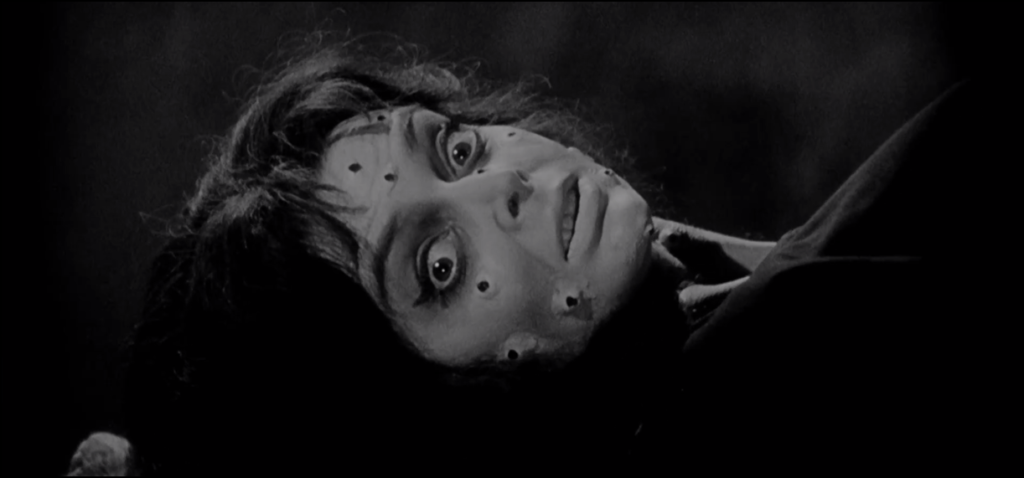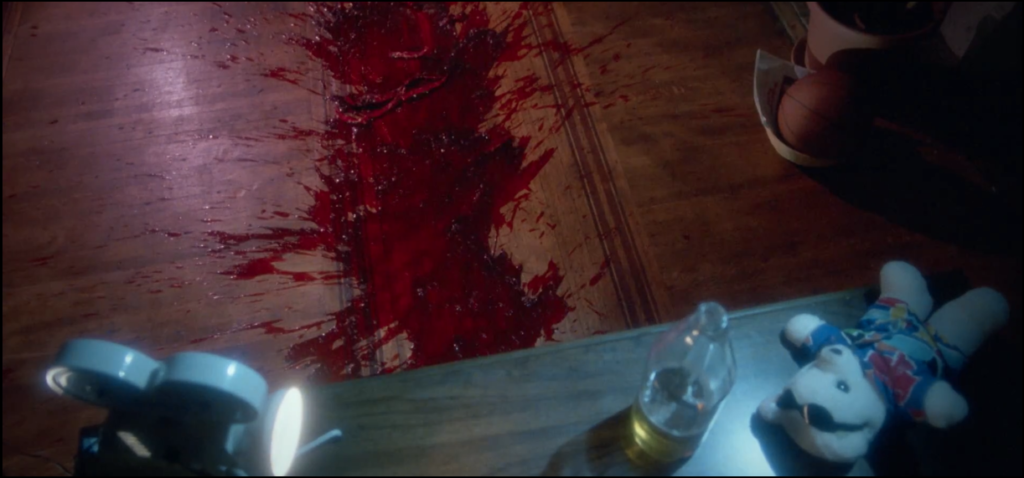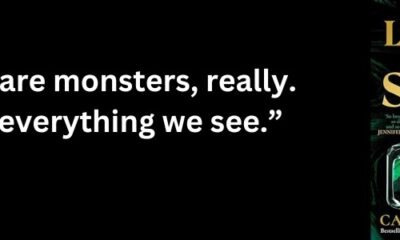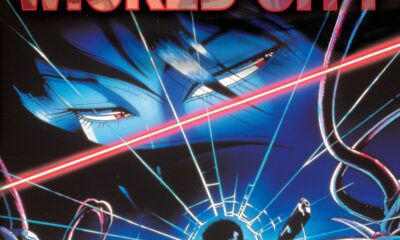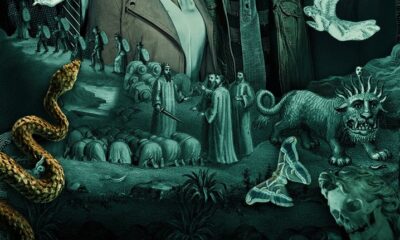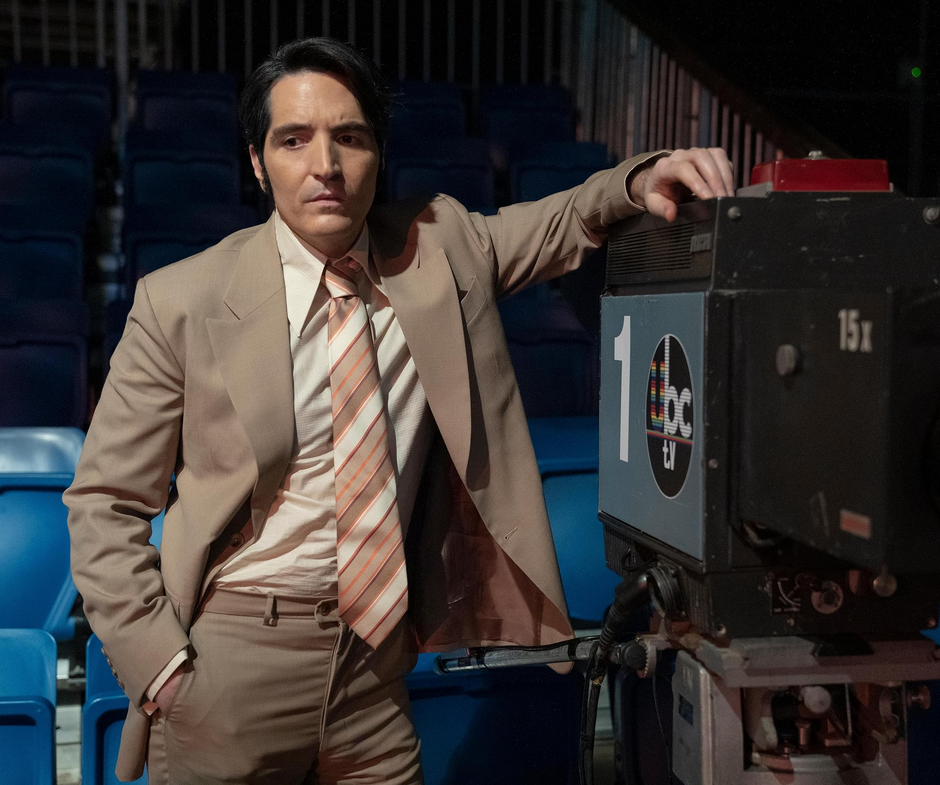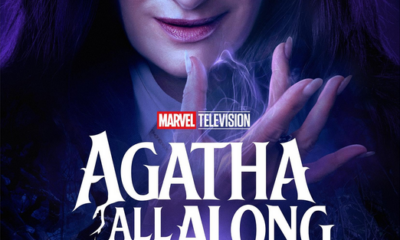
Notes from the Last Drive-In: S4E2 – ‘Black Sunday’ and ‘Def By Temptation’
More Videos
Published
2 years agoon
Welcome to ‘Notes from the Last Drive-In’ where we cover season 4, episode 2 of The Last Drive-In with Joe Bob Briggs on Shudder. This week we are talking about the horror classics Black Sunday (1960) and Def By Temptation (1980) and how they related to… Walpurgisnacht? Okay then!
We are back after last week’s season four premiere and the 100th and 101st films shown at the drive-in. You know you’re in for a treat when Joe Bob has a cause and the maps come out. So how successfully do the night’s films mesh with the theme of European witch lore festivals? Let’s find out together, shall we?
The Orthodox Church is the more goth Catholic Church anyway#thelastdrivein @therealjoebob @kinky_horror @shudder— Haunted MTL 🏳️🌈 (@HauntedMTL) May 7, 2022
Black Sunday (1960)
Barbara "Squeaky Wheel" Steele#thelastdrivein @therealjoebob @kinky_horror @shudder— Haunted MTL 🏳️🌈 (@HauntedMTL) May 7, 2022
Black Sunday, or La Maschera del Demonio, is the landmark 1960 Italian horror film directed by icon Mario Bava, which also happened to be his directorial debut. The stars of the film include Barbara Steele, John Richardson, Andrea Checchi, Ivo Garrani, and Arturo Dominici. Of the cast, Steele would become the most familiar to Americans, though Richardson, Checchi, and Garrani would be very familiar to Italian audiences and Italian film enthusiasts.

The film, very loosely adapted from the story “Viy” by Nicholai Gogol, is a lush, gothic fairy tale set in 1800s Moldavia about a land and a family cursed by a witch upon her death that would play out two centuries later. The film plays with multiple fairy tale themes and images and is unique in that it represents the foundations of post-war Italian horror, as Drive-In fans would come to learn throughout the night.
The story itself is very loose as a “Viy” adaptation goes, more or less borrowing tone above anything else. The narrative is simple with many scenes of melodrama, castle wanderings, and supernatural encounters that do not follow conventional logic. However, that is not necessarily a slight against the film. The events on the screen are like that of a dream. The film more or less meanders through the story to get to real meaty moments of witchy horror.
Barbara Steele owns the film in a dual role of the witch Asa Vajda and her descendent Katia Vajda. She is magnetic as Asa, a woman of erotic evil, and as her foil, the virginal and sweet Katia. The film would launch the English actress’ career as an Italian horror superstar, something she apparently had mixed feelings on. Regardless, she is the strongest performer in the cast, and that is saying something considering the work of other Italian cinema legends of the film, who are suitably game for what Bava throws at them.
As for Mario Bava, the film would serve as his debut as a director, having spent years as a cinematographer. His directorial work is a marvel here, and surprisingly modern given the influences of fairy tales and the gothic trappings of Hammer Horror that inspired the approach to the material. Between Bava and his camera, there is a sort of magic that unfolds on screen, and even today, over 60 years out, the film looks and feels astoundingly modern. Bava’s cinematographic eye does as much of the lifting of the film as Steele’s performance.
Joe Bob-servations on Black Sunday
Among some of Joe Bob Briggs’ observations on the film was a fascinating discussion on the nature of Black Sunday as a film for export. Specifically, the production company Galatea and their emphasis on genre films led to an explosion of sword-and-sandal flicks that proved moderately successful overseas, such as Hercules (1958) and Hercules Unchained (1959).
The issue, though, was that Italy did not really have a contemporary horror scene from which to draw. The history is of course tied into the years of fascism associated with Mussolini, which Joe Bob lays out. What we discover over the course of the film is how Black Sunday becomes the foundation of Italian horror and ends up leading to the staple of the Italian Giallo film.
This is, of course, between gags of a progressively hammered Joe Bob trying to bring back Walpurgisnacht. It was a fun night.
Final Thoughts on Black Sunday
While loose in structure and perhaps a bit too deep into the dream logic of fairy tales, Black Sunday is an iconic witch film and a foundational text in Italian horror. Between the direction and photographic eye of Mario Bava in his directorial debut, and the on-screen magnetism of actress Barabara Steele, there is something about Black Sunday that sticks with viewers. Joe Bob Briggs gave the film four stars. My hangups with the lack of focus and some pacing issues in the film leave me to give it four out of five Cthulhus.

Best Line: “In life? What is my life? Sadness and grief. Something that destroys itself day by day, and no one can rebuild it. Here is the very image of my life. Look at it. It’s being consumed hour by hour like this garden, abandoned to a purposeless existence.” – Asa (a bit on the nose but she makes it work)
Def by Temptation (1990)
Lady in Red? Dancing with me?#thelastdrivein @therealjoebob @kinky_horror @shudder— Haunted MTL 🏳️🌈 (@HauntedMTL) May 7, 2022
Def by Temptation is a fascinating 1990 black horror film starring and directed by James Bond III. The film also stars Kadeem Hardison, Bill Nunn, and Cynthia Bond with appearances by Samuel L. Jackson, Minnie Gentry, Melba Moore, and Freddie Jackson. Most of the cast would be associated with Spike Lee’s School Daze (1988) or the music management label Hush. The film would ultimately be distributed by Troma and even have Lloyd Kaufman help film the movie’s chaotic conclusion.
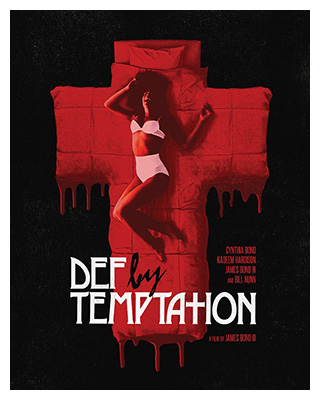
The film follows a group of men, a wannabe minister, an actor, and a cop, who find themselves involved with a succubus who is preying on black men on the streets of New York City. The late 1980s urban aesthetics and hip-hop and R&B score create a wonderful play on the vampire film.
Def by Temptation has a lot going for it. The story is well-paced and does a good job blending contemporary themes of masculinity with predation anxiety all wrapped up in a supernatural shell. The film does have inconsistencies with internal logic, but that doesn’t matter much when a succubus vampire is involved and a character gets Cronenberged into a television set. The film is fast and loose in borrowing from different themes and concepts and while that does result in a somewhat messy and scattershot story, the experience as a whole is quite memorable. A lot of that comes from Bond’s direction for what is clearly a passion project.
Part of the film’s appeal comes from the performances in which there is not a phoned-in performance in the cast. Each actor does their thing very, very well and can be praised for their timing, delivery, and presence. Some of these performances are so strong, however, that viewers may be shocked to discover that this film is one of the last films of two of the performers. James Bond III would quit acting and directing. He only recently resurfaced as a producer after 2009. Cynthia Bond, who is fantastic as the Temptress, would fill in a few television roles until about 1994, and would only resurface in the mid-2010s as the author of the best-selling book Ruby.
The film is gorgeous and among some of the best visuals in any film Troma has ever distributed. It helps that Spike Lee collaborator Ernest Dickerson served as cinematographer. His career would be substantial, with Def by Temptation being only one of many horror films in his filmography. As much as a cliche as this can sound, Dickerson’s framing and camera work turn the locations into characters themselves, be it a bar, apartment, street, or dream-like bedroom and jazz performance space.
Joe Bob-servations on Def by Temptation
If the theme of the night was witches, I would argue that Def By Temptation was a bit of a stretch. The Temptress of the film is more of a vampire or succubus than a witch, though she does bewitch men. It is a reflection of the loose rules established in the world. Regardless, it is a fun film and there was a lot to learn about it. Case in point, Joe Bob had a few things to say on the Troma-side of the film’s history, namely the fact that Lloyd Kaufman believes it to be the best film Troma ever distributed.
Another fun and surprisingly Troma-angle? Lloyd Kaufman himself picked up the camera to help film the chaotic ending as Dickerson had already moved on to another project.
Plenty of factoids were on hand as well, such as the strange case of Cynthia Bond who was a mystery to most of the cast. There were also other examples of the independent spirit running throughout the movie, such as the fact the apartment scenes were shot in the apartment of Laurence Fishburn, or that most of the funding of the film came from the cast and crew.
Final Thoughts on Def by Temptation
Def by Temptation is a fascinating movie that rides that line right between the 1980s and 1990s and should be considered a key text in black horror. The film may be inconsistent in its own rules and might be a patchwork of influences and excuses for gore, at times, but the film has some interesting things to say on the treatment of black bodies. The performances are well worth a mention as well, with every actor nailing their part. Joe Bob Briggs gave the film three-and-a-half stars. I found the film to be incredibly fun, so I’d give it four-out-of-five Cthulhus.
 (4 / 5)
(4 / 5)
Best Line: “Hey, baby, we had a good time – you can get an abortion now.” – Bartender
Haunted MTL Drive-In Totals
As always, here are the official Drive-In Totals.
Gratuitous tuba AND timpani, trombone and pipe organ fu? 🤘 #TheLastDriveIn pic.twitter.com/o9VN7Jrjhi— Shudder (@Shudder) May 7, 2022 "Flesh-Eating Regurgitating TV Set", you say?
The Cronenberg Cinematic Universe is confirmed. #TheLastDriveIn pic.twitter.com/ELcYA2cAX9— Shudder (@Shudder) May 7, 2022
As for our own totals, we have…
- 2 “Thee-Ate-Ers”
- 3 Types of Alcohol
- 3 Gilligan Cuts
- 8 Halloweens a Year
- 18 Beers
- Bat Shredding
- Orgy Proposing
- Cow Milking
- Tactical Sam Jackson Deployment
- Gratuitous European History Lessons
- Gratuitous Piano
- Gratuitous House Clattering
- Cane Fu
- Fainting Fu
- Binge Drinking Fu
- Banana Fu
- Darcy Cosplay: Asa
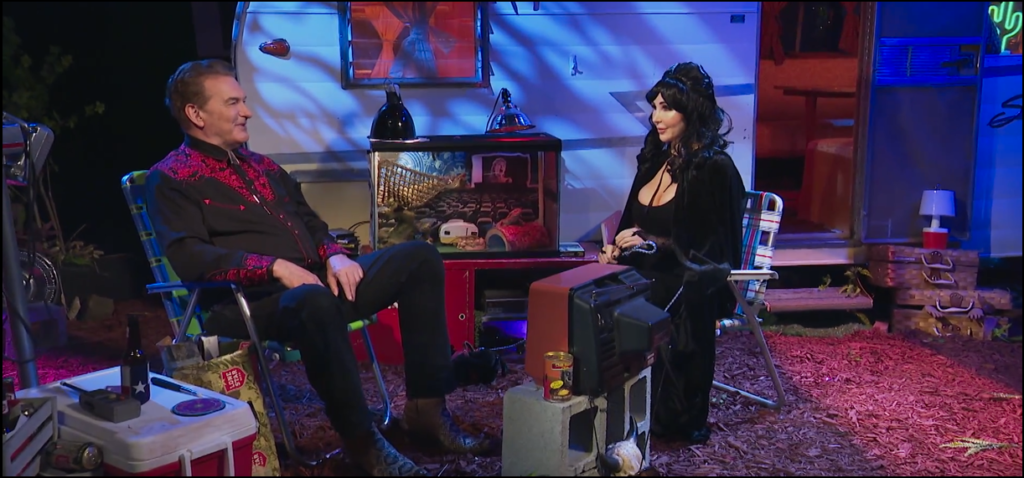
Episode Score for Notes from the Last Drive-In: S4E2 – Black Sunday and Def by Temptation
The theme of the night was, ostensibly about witchcraft, though there is a larger connection to demons given the origins of witchcraft which sort of explains how Def by Temptation fits in. What is important is that the wrapper for the show this week was one of the funnier and stranger ones the show has done, with Joe Bob sliding into a darker and darker drunken stupor as he tries to “bring back” Walpurgisnacht. The interplay between Joe Bob and Darcy was a great deal of fun, and with any “cause” our host takes one there was plenty of history involved.
With that being said, I do think the pairing was a bit stretched given the theme suggested by our host, here. I think the movies pair well, but in that regard, I think a stronger thematic hook would have been “dangerous women” rather than the return of Walpurgisnacht. There is an association between women and the festival, of course, but I just feel the execution here, as fun as it was, ended up a bit muddled.
Anyway, hopefully, they got Joe Bob’s stomach pumped after the combination of alcohol. You couldn’t pay me to drink mead.

Please join us on Twitter next Friday as we live-tweet with the rest of the Mutant Fam during The Last Drive-In with Joe Bob Briggs. As always, thanks for reading, and please share your thoughts on the movies, the show, or even these reviews/recaps. We would love to know what you have to say.
PUT ZE CANDLE… BACK!#thelastdrivein @therealjoebob @kinky_horror @shudder pic.twitter.com/Qp0oxlTll0— Haunted MTL 🏳️🌈 (@HauntedMTL) May 7, 2022
Enjoyed Def by Temptation?
Want to add more Troma films to your library? Check out these sponsored links on Amazon. Buying through our sponsor link helps out Haunted MTL.
David Davis is a writer, cartoonist, and educator in Southern California with an M.A. in literature and writing studies.

You may like
Movies n TV
Wicked City (1987), a Film Review
Wicked City (1987) is a dark fantasy horror animation following a world at the brink of war as mortals and supernatural being clash.
Published
1 day agoon
October 22, 2024
Wicked City (1987) is a dark fantasy horror and the debut feature-length animation of director Yoshiaki Kawajiri. This unrated film adapts the first novel of the Wicked City series, Black Guard. It stars Yûsaku Yara, Toshiko Fujita and Ichirô Nagai. As of this review, Wicked City is available on Prime and Crunchyroll.
As the peace between the mortal and supernatural worlds ends, forces clash in a plot to establish a new order. Tasked with protecting the best chance for peace, Taki (Yûsaku Yara) must guard Giuseppe Mayart (Ichirô Nagai). A Black Worlder named Makie (Toshiko Fujita) remains his partner in this pursuit. Can the three brave the challenges and establish a world of peace?
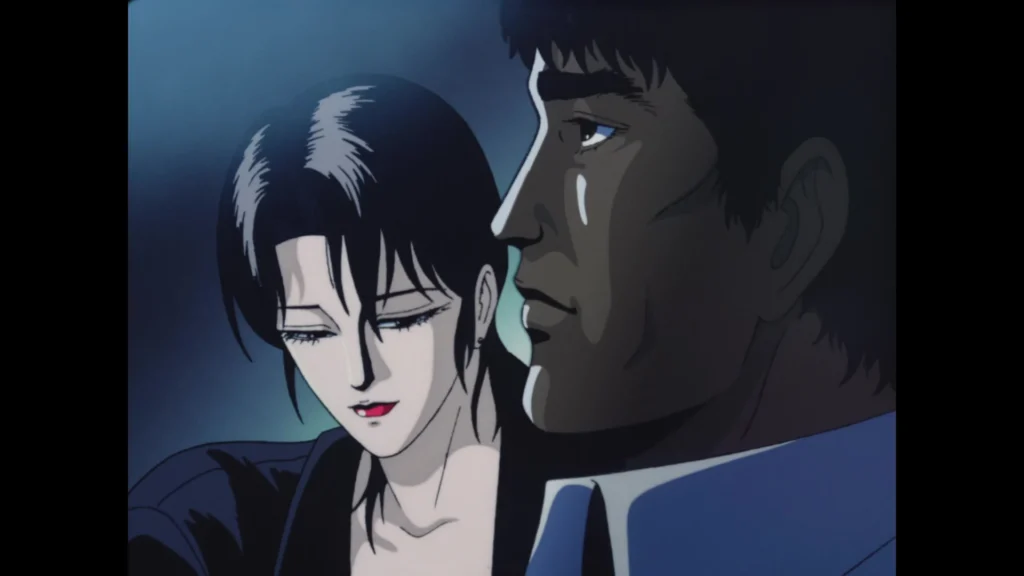
What I Like about Wicked City
Wicked City works best in its parts, providing strong and interesting elements that don’t inherently add up to the whole. The art style and design evoke a memorable aesthetic. There’s a charm to this 80s-era anime that creates either an environment for abominations or spectacles.
It makes sense that Wicked City is an adaptation because the plot depicted seems like parts of a larger narrative we do not see in the film. From what remains, the world and political scheming seem worth exploring. Unfortunately, little of this plot receives depth.
Prior to this, Yoshiaki Kawajiri contributed to many TV shows, exercising a new muscle as he directed a film-length work. He seems invaluable on a team, as his filmography and success indicate, but his directorial contributions don’t seem as critically successful. This effort and work best express themselves in the level of animation and scenes depicted in this flawed film.
Despite the missing pieces throughout the film, the ending seems complete. While there’s clearly room for a sequel, Wicked City tells its story and suggests an answer to the new era’s direction.
Supposedly, this started out as a short film, but Yoshiaki Kawajiri’s execution earned enough attention and respect to get a green light for a feature-length film. This work was all done within a year. Assuming this is true, Wicked City’s completion and animation quality deserve respect.
It received a live-action adaptation. From my understanding, the film adapts the anime, but I hope and imagine some of the manga gets explored to make a more functioning plot.

Tired Tropes and Triggers
Sexual assault and rape remain grotesquely overused in the film. Such subject matter has a place in art, but its use in Wicked City gravitates more toward exploitation and spectacle. Many of the visual designs make most of the fight allegories for sexual assault atop the actual assaults.
As most creatures are organic, there’s a heightened amount of body horror. There’s a level of separation in animation as opposed to live-action body horror, but this point certainly applies to those sensitive to such material.
From what we learn of the characters, many decisions directly contradict their supposed purpose.
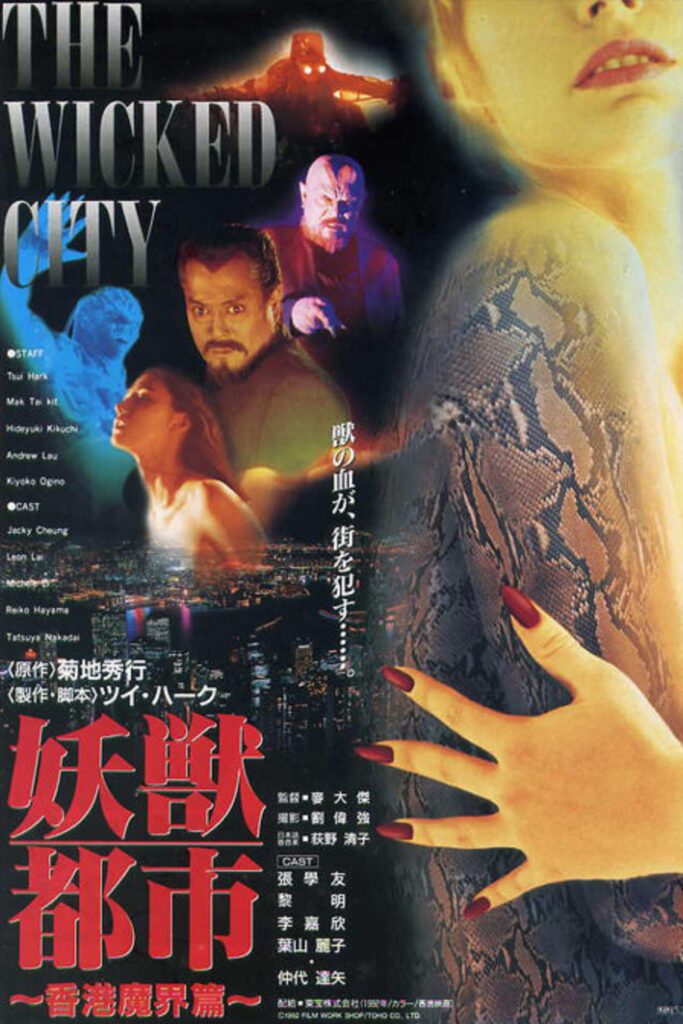
What I Dislike about Wicked City
Wicked City circles forums and rank-listings as a cult classic or niche horror, but it’s flawed in almost every way. Ideally, such works might have a plot that draws one in. Wicked City has a concept of a plot that evokes interest but doesn’t communicate it well or explore its depths. Ultimately, it’s a film made up of its parts. The good gets outweighed by the dysfunctional points.
Frankly, the romantic tension between the two leads is underdeveloped. I hesitate to say it doesn’t exist because there’s some work implemented with this in mind. Viewers note the work in the film, but it lacks polish or sensibility.

Final Thoughts
Wicked City is a flawed work from a successful animator. If given more time to develop, perhaps a staple of the 80s might exist. Unfortunately, the film has merits in its parts but falls in connection to the whole. However, for those who can overlook the limitations and exploitations, there are many worthy parts that excel in terms of animation quality and creative decisions.
Released in 2023, Late Night with the Devil is a found-footage movie about a late-night host who’d do anything to have the top-rated show.
Don’t worry, it’s not about Jay Leno.
The story
Our story begins, as many found footage films do, with a quick explanation. What we are going to see is the surviving footage from the last episode of a late-night show, along with some never-before-seen footage of backstage during the fateful night everything went wrong.
We then meet Jack Delroy. He’s a late-night host of the show Night Owls. And a year after the death of his beloved wife, he worries that his show is going to be canceled. The ratings are freefalling. So, on Halloween, he invites a girl named Lilly on the show who claims to be possessed.
Because that’s going to go well.
The show begins with a monolog, like most late-night shows. We then meet the first two guests, a claimed psychic named Christou and a stage magician slash skeptic named Carmichael Haig. After hot-reading the audience, Christou appears to have a real psychic vision. One that involves Jack’s deceased wife. He then proceeds to vomit black sludge all over the stage.
You’d think that would be the end of things. It would be stupid to still bring on the possessed girl after a warning like that.
But, of course, the show must go on.
What worked
Late Night with The Devil dedicated itself to the found footage vibe. As such, it felt very much like you were watching something from the 70s. The whole movie is at a lower, grainy resolution, unlike some other horror films that eventually and subtly switch out for a more modern and clear picture. The clothes, the music, the cheap and cheesy costumes. It all reminds one of a good episode of the Brady Bunch or Bewitched. Even when someone’s puking black blood or has worms pouring out of their freshly opened gut.
I was also quite impressed by the acting in this film. Especially that of David Dastmalchian, who played Jack Delroy. This role was performed to perfection. Jack manages to come off as a kind, compassionate man. The sort of person you’d be comfortable talking to, even about the most horrible moments of your life. You get the feeling that you could tell him about the worst moments of your life and he’d thank you for sharing.
This kind facade never slips. But we also see his true motivations. He doesn’t care about anyone, no matter how kind he acts. The show must go on is his entire drive and mission. He didn’t let a little thing like a guest dying stop him. Or a mental breakdown on stage. Or even his dead wife calling to him from beyond the grave.
The show must go on. And on, and on.
Even Dastmalchian is outshined, however, by Ingrid Torelli who played Lilly.
Lilly was a creepy character from the first time we saw her. There is something so unnerving about a child who knows far more than they should. This is a hallmark of demon possession films, all the way back to Reagan. But there’s also something else about the way she behaves that has little to do with the possession. She is always looking to either June or Jack for direction. As much as she speaks to the adults like she knows one, she is still always looking to please the adults around her. She is eager to look at the right camera at the right moment. She is eager to be obedient. It’s hidden, but for someone who has seen enough cult content, it’s easy to spot. She played a former cult victim very well. And that was perhaps the most terrifying part of that character.

What didn’t work
This was almost a perfect movie. Then, like so many others, it just couldn’t stick the landing.
Near the end of the film, there is a strange scene that doesn’t seem to mesh with the rest of it. It appears to be a collection of Jack’s memories. Whether they are true memories or not is left to our interpretation. But they explain the entire reveal of the whole movie. In dull, excruciating detail.
This series of scenes was insulting. It was the equivalent of asking someone if they got the joke. But are you sure you got it? Wait, let me explain it and really just kill the effect altogether.
We were already laughing. Or, to step away from this metaphor, we were already creeped out. We were already grossed out. We were already living in the scene, sitting in the audience right next to the lady who lost her son or the man dressed as a skeleton. Rather than explain the twist, which didn’t need explaining, this scene pulls us rudely out of that audience and deposits us back in the real world.
All that being said, Late Night with The Devil is still a terrific horror film. It was dark, it was gorey, and it left us with unsettling questions even after the ill-planned info dump. If it isn’t already on your Halloween watch list, it certainly deserves a spot.

Movies n TV
“B is for Brain” (Evil: S2E8)
“B is for Brain” is an episode of the supernatural drama Evil. The assessors investigate new brain mapping research.
Published
2 days agoon
October 21, 2024
“B is for Brain” is an episode of the supernatural drama Evil, created by Michelle King and Robert King. The central cast includes Katja Herbers, Mike Colter, Aasif Mandvi, Michael Emerson, Christine Lahti, and Andrea Martin. It originally aired under CBS before moving to Paramount+. As of this review, it’s available through Netflix and Paramount+ and its add-ons.
The assessors investigate new brain mapping research that might expose others to God and Hell. Kristen (Katja Herbers) struggles with aggression as Andy (Patrick Brammall) returns from his expedition. Ben (Aasif Mandvi) struggles with what he sees while in the brain mapping process. David (Mike Colter) returns to the basics to find God.
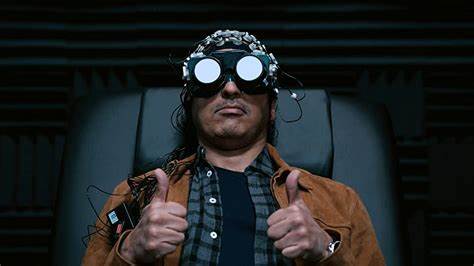
What I Like about “B is for Brain”
“B is for Brain” provides a unique opportunity for viewers to gain more insight into Ben’s past. While not his episode, as “B is for Brain” balances the leads nearly perfectly, he has his most emotional moment in the series so far. Despite the lower stakes, it provides a more vulnerable moment than “E is for Elevator.”
Leland (Michael Emerson) and Sister Andrea (Andrea Martin) meet again on more equal terms and establish their hostile relationship. Sister Andrea proves herself to be a woman who doesn’t back down when a Satanist tries to intimidate her. It also raises the necessity of David’s training, creating a more tangible threat.
Kristen’s deteriorating relationship with Andy reaches a boiling point as her impulsiveness and hostility reach new heights. It seems her sabbatical to the monastery might have increased the evil influences. “B is for Brain” builds upon what “S is for Silence” introduces and creates an interesting interpretation of the last episode’s events.
“B is for Brain” brings a new dynamic to its horror by focusing on how technology, science, and religion intersect. There’s an incredibly diabolical conversation on how this technology could induce fear to empower religion. This idea evokes a more subtle horror than most episodes.

Tired Tropes and Triggers
There is a potential nay-theist trope. By that, I mean there’s a single line where one can interpret an atheist character turned from God because God turned from them. It’s a single line that remains interpretable, but it’s worth mentioning.
There’s a moment of self-harm with clear implications that this is a pattern with the specific character. This harm has some implication of demonic influence, but this remains unconfirmed at the moment. I will mention this becomes more obvious as the season continues.
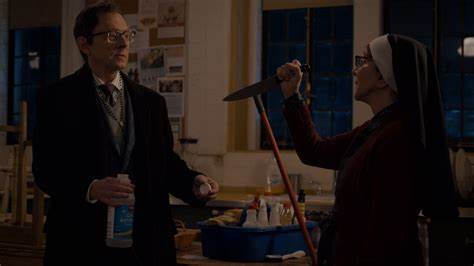
What I Dislike about “B is for Brain”
Unfortunately, such a big reveal for Ben’s character doesn’t have time to get fully explored in “B is for Brain.” While the focus between the three is great, a few big reveals only earn a light address. It’s less that Ben doesn’t get a fair amount of attention and more that these subjects don’t receive that attention.
A similar point remains relevant about the claim of using brain mapping as a way of evoking religious conversion. That point merits interrogation from the characters and the plot, but it’s only lightly touched on. Further expanding these points is that there’s only light reference in the future specifically about brain mapping.

Final Thoughts
“B is for Brain” gets placed into two memorable episodes, diminishing its lasting power. While not a fault of the episode, it does overlook some potentially big reveals. Some of the more relevant character moments will receive the attention they deserve in later episodes, but it doesn’t aid “B is for Brain” in execution. While a strong and enjoyable episode, diving into those moments might have created an episode that haunts the viewer.

